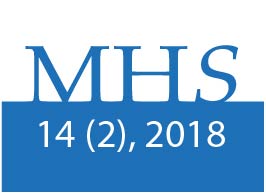DETERMINATION OF ANTHROPOMETRIC CHARACTERISTICS AND MAXIMUM CONSUMPTION OF OXYGEN OF COSTA RICAN PROFESSIONAL CYCLISTS BY AREA OF EXPERTISE AND TYPE OF RACE
DOI:
https://doi.org/10.15359/mhs.14-2.5Keywords:
body composition, aerobic capacity, mountain biking, road cyclingAbstract
The purpose of this study was to determine anthropometric characteristics and the maximum consumption of oxygen (VO2max) of professional Costa Rican cyclists. A total of 22 cyclists participated with an average age of 24.7 ± 3.7 years, a body weight of 64.5 ± 2.7 kg, height of 1.73 ± 0.02 m and competition experience of 10 ± 2.3 years. The following were the variables used: weight, height, body fat percentage and VO2max, which was measured directly. Data obtained was analyzed through descriptive statistics (averages and standard deviation), t-student for independent groups and one-way ANOVA with Tukey post hoc. No significant statistical differences were recorded in the following variables: weight (t(20)=0.24; p=.82), height (t(20)=1.37; p=.19), body fat percentage (t(20)=0.90; p=.38) and VO2max (t(20)=0.03; p=.98) among the cyclists that only do road cycling and those who do both road and MTB, depending on the type of race. On the analysis by area of expertise, significant differences were detected only in body weight (F(2,21)=4.95; p=.02) showing that time trialists are significantly heavier than climbers. Conclusion: anthropometric and cardiorespiratory characteristics by type of race and area of expertise of Costa Rican cyclists are similar, except for body weight, which was significantly greater in time trialists than climbers.
References
American Collage of Sport Medicine (2014). ACSM's Guidelines for Exercise Testing and Prescription. 9th Ed. Philadelphia: Lippicontt Williams & Wilkins.
Coutinho, H., Trigueiro, J., da Silva, W., dos Santos, C., & Soares, A. (2011). Análise antropométrica comparativa entre a elite de ciclistas de estrada pernambucanos e a elite de ciclistas australianos. RBPFEX-Revista Brasileira de Prescrição e Fisiologia do Exercício, 3(13), 63-68. Recuperado de http://www.rbpfex.com.br/index.php/rbpfex/article/viewFile/143/147
Crouter, S,E., Antczak, A., Hudak, J.R., DellaValle, D.M, Haas, J,D. (2006). Accuracy and reliability of the ParvoMedics True One 2400 and MedGraphics VO2000 metabolic systems. Eur J Appl Physiol, 98(2), 139-51. Doi: 10.1007/s00421-006-0255-0
Faria, E., Parker, D., & Faria, I. (2005). The science of cycling. Sports medicine, 35(4), 285-312. Doi: https://doi.org/10.2165/00007256-200535040-00002
Impellizzeri, F., & Marcora, S. (2007). The physiology of mountain biking. Sports medicine, 37(1), 59-71. Doi: 10.2165/00007256-200737010-00005
Impellizzeri, F,M., Ebert, T., Sassi, A., Menaspà, P., Rampinini, E., & Martin, D.T.(2008). Level ground and uphill cycling ability in elite female mountain bikers and road cyclists. Eur J Appl Physiol, 102(3), 335-41. Doi:10.1007/s00421-007-0590-9
Jeukendrup, A., Craig, N., & Hawley, J. (2000). The bioenergetics of world class cycling. Journal of Science and Medicine in Sport, 3(4), 414-433. Doi: http://dx.doi.org/10.1016/S1440-2440(00)80008-0
Lee, H., Martin, D., Anson, J., Grundy, D., & Hahn, A. (2002). Physiological characteristics of successful mountain bikers and professional road cyclists. Journal of Sports Sciences, 20(12), 1001-1008. Doi:10.1080/026404102321011760
Lopategui, E., (2012). Experimento de Laboratorio F-11. Prueba submáxima en el cicloergómetro. (Prueba de Söstrand Modificada por la YMCA) Recuperado de http://www.saludmed.com/LabFisio/PDF/LAB_F11-Sostrand_YMCA.pdf
Lopategui, E., (2008). Experimento de Laboratorio H-18, determinación de la composición corporal: método de plicometría o pliegues subcutáneos. Recuperado de http://www.saludmed.com/LabFisio/PDF/LAB_H18-Porciento_Grasa.pdf
Lucía, A., Hoyos, J., & Chicharro, J.L. (2000). The slow component of VO2 in professional cyclists. British journal of sports medicine, 34(5), 367-374. Doi: 10.1136/bjsm.34.5.367
Lucía, A., Hoyos, J., & Chicharro, J.L. (2001). Physiology of professional road cycling. Sports medicine, 31(5), 325-337. Doi:10.2165/00007256-200131050-00004
Lucía, A., Joyos, H., & Chicharro, J.L. (2000). Physiological response to professional road cycling: climbers vs. time trialists. Int J Sports Med, 21(7), 505-12. Recuperado de https://www.researchgate.net/publication/12256684_Physiological_Response_to_Professional_Road_Cycling_Climbers_vs_Time_Trialists
Martínez, L., Fideu, M., & Ferrer, V. (1993). Estudio cineantropométrico en 58 ciclistas de competición. Archivos de medicina del deporte, X, 38, 121-125. Recuperado de http://femede.es/documentos/Cineantropometria_ciclismo_121_38.pdf
Menaspà, P., Abbiss, C., & Martin, D. (2013). Performance analysis of a world-class sprinter during cycling grand tours. International journal of sports physiology and performance, 8(3), 336-340. Doi: https://doi.org/10.1123/ijspp.8.3.336
Padilla, S., Mujika, I., Cuesta, G., & Goiriena, J. J. (1999). Level ground and uphill cycling ability in professional road cycling. Medicine and science in sports and exercise, 31(6), 878-885. Doi: https://doi.org/10.1097/00005768-199906000-00017
Peinado, A., Benito, P., Díaz, V., González, C., Zapico, A., Álvarez, M., Maffulli, N., & Calderón, F. (2011). Discriminant analysis of the specialty of elite cyclist. Journal of Human Sport And Exercise, 6(3), 480-489. Doi:10.4100/jhse.2011.63.01
Schmitz, H., Van Breda, E., & Kuipers, H. (2007). Physiological parameters in professional and elite amateur road cyclists (Tesis sin publicar). Maastricht University, Paises Bajos, Europa.
Swain, D. (1994). The influence of body mass in endurance bicycling. Medicine and science in sports and exercise, 26(1), 58-63. Doi: 10.1249/00005768-199401000-00011
Tuche, W., Fazolo, E., Assis, M., Dantas, P., & Fernandes, J. (2005). Perfil dermatoglífico e somatotípico de ciclistas de alto rendimento do Brasil. Revista de Educação Física, 132, 14-19. Recuperado de http://www.researchgate.net/publication/228802966_Perfil_dermatoglfico_e_somatotpico_de_ciclistas_de_alto_rendimento_do_Brasil
Downloads
Published
How to Cite
Issue
Section
License
General conditions
MHSalud: Journal in Human Movement Sciences and Health by the Universidad Nacional is cover under a Creative Commons Atribución-NoComercial-SinDerivadas 3.0 Costa Rica license.
The journal is hosted in open access repositories such as the Institutional Repository of the Universidad Nacional, the Kimuk Repository of Costa Rica and La Referencia.
The editorial source of the journal must be recognized. Use the doi identifier for this purpose.
Self-archiving policy: The journal allows the self-archiving of the articles in their peer-reviewed version, edited and approved by the Editorial Board of the Journal to be available in Open Access through the Internet. More information in the following link: https://v2.sherpa.ac.uk/id/publication/25815



















